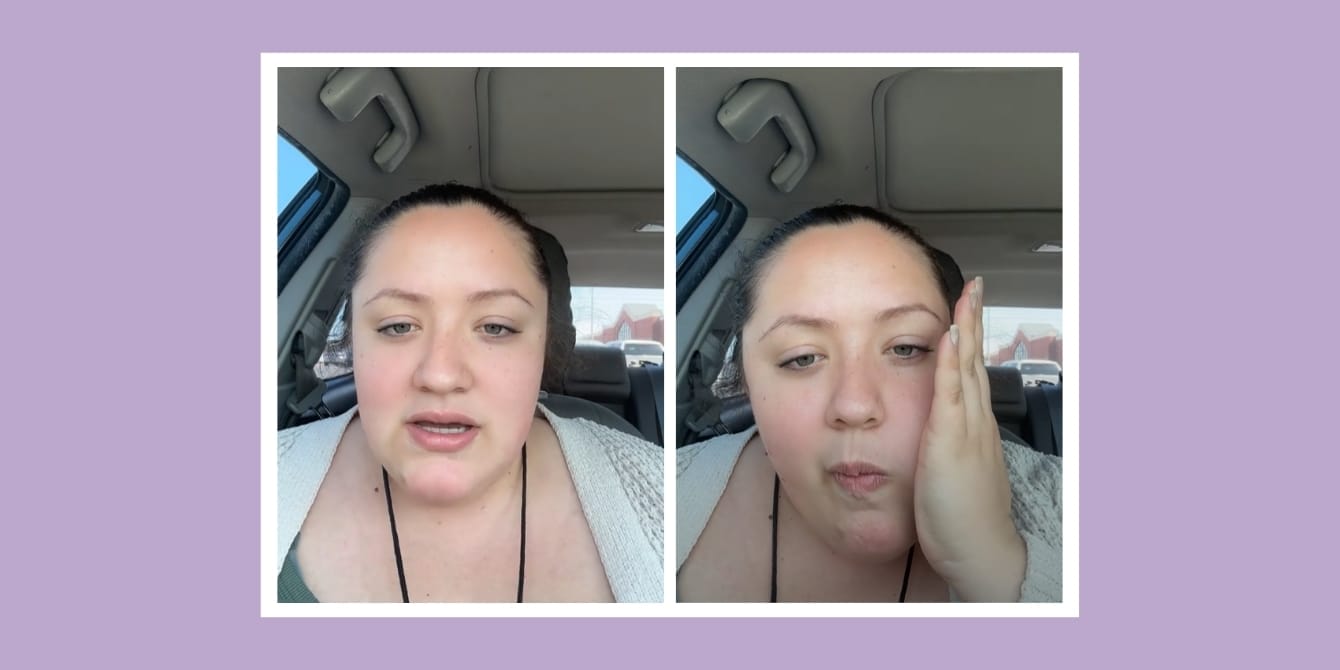Trying to describe what it feels like when a baby moves inside you is a bit like trying to explain what déjà vu feels like—vivid, strangely specific, and somehow completely elusive. For expectant parents, it’s one of those sensations that’s both magical and hard to articulate. But thanks to a TikTok from creator @__mmkayy, or Kat, we finally have an explanation that just…clicks.
In a now-viral video, Kat breaks down the bizarrely beautiful feeling of baby movement with an analogy that’s not only spot-on but also incredibly easy to try for yourself. And judging by the 2.7 million views and thousands of comments, she’s not the only one who thinks so.
A moment of clarity: The viral tiktok that explained baby kicks
It all started when Kat was at work, and a curious coworker asked her the age-old question: “What does it feel like when the baby moves?” The mom-to-be found herself stumped. After all, how do you explain that mysterious, often subtle sensation of a little one shifting inside you?
Rather than leaving her coworker hanging, Kat decided to experiment. She thought through the feeling, trying to find the right words. Then it clicked: “It’s like when you put your hand on your cheek and move your tongue.” Yes, really.
Kat quickly recorded a TikTok video to share this revelation. “It’s a soft but firm, slow kind of movement,” she explains, touching her cheek and mimicking the tongue movement. And just like that, the lightbulb went on for viewers everywhere.
What followed was an outpouring of admiration and recognition from fellow moms who felt exactly what Kat described. Her simple, yet brilliant analogy struck a chord, and the video quickly racked up millions of views.
Related: It’s science: 5 ways to awaken baby’s senses in the womb
Why the description strikes a chord
What makes this description so impactful is how it cuts through the usual metaphors people often use to describe baby kicks. Whether it’s “butterflies” or “gas bubbles,” those comparisons can sometimes feel a little too vague. But this analogy is refreshingly specific—and tangible. By comparing the sensation to the feeling of a tongue moving on your cheek, it offers a relatable, hands-on way for people to connect with the experience.
For many expectant parents, the feeling of a baby moving inside can be hard to explain. The beauty of this description is in its simplicity and clarity. It resonates because it’s a feeling we can all understand, and it’s the kind of explanation that makes you nod in recognition and think, “Yes, that’s exactly it!”
This is a perfect example of how shared experiences—especially those that can be tough to put into words—bring people together. In a world where pregnancy is often discussed in abstract terms, this simple, grounded explanation is a breath of fresh air.
Related: This new finding about why babies move so much in the womb is fascinating
What people are saying
For many expectant parents, the feeling of a baby moving inside can be hard to explain. The beauty of this description is in its simplicity and clarity. It resonates because it’s a feeling we can all understand, and it’s the kind of explanation that makes you nod in recognition and think, “Yes, that’s exactly it!”
This is a perfect example of how shared experiences—especially those that can be tough to put into words—bring people together. In a world where pregnancy is often discussed in abstract terms, this simple, grounded explanation is a breath of fresh air.
The comments section quickly became filled with reactions from people who couldn’t help but appreciate how accurate and relatable the analogy was. Some were even inspired to try it out for themselves:
- Alyssa: “The way you’ve got a few hundred thousand people pressing their hands on their faces and wiggling their tongues against it 😂😂 you hold a lot of power ma’am”
- ThePrettyOnion🆘🇺🇸: “This is so accurate I just got nostalgic.”
- C h e y e n n e 🤍: “You need to get paid for this info somehow because absolutely correct 😭”
- Brittany Oldehoff: “This deserves more credit than it has.”
- Melrae320: “YOU CRACKED THE CODE!!”
- Sarah: “OMG YES YOURE RIGHT!!!!!!! Holy cow this is the best analogy I’ve ever heard.”
Related: Is your baby kicking a lot? Research explains the reason fetuses move so much
FAQs
Q: When will I feel my baby move for the first time?
A: Most people feel their baby move between 16 and 25 weeks of pregnancy. If it’s your first pregnancy, it might happen a little later, as you may not recognize the sensation right away.
Q: What does a baby kick actually feel like?
A: Early movements can feel like fluttering, gas bubbles, or light tapping. They might even feel like a little tongue pressing against your cheek (thanks, TikTok!). As the pregnancy progresses, the movements become stronger, and you’ll likely notice more defined kicks and shifts.
Q: How often should I feel my baby kick?
A: By the third trimester, you should feel regular movement. Many providers recommend doing daily kick counts—you should feel 10 movements in 2 hours. If you don’t feel regular movement, it’s always a good idea to check in with your healthcare provider.
Q: When should I be concerned about baby movement?
A: If your baby’s movements seem less frequent or weaker than usual, it’s important to contact your provider. It’s always okay to ask for reassurance and make sure everything is okay.
Q: Do anterior placentas affect how kicks feel?
A: Yes, an anterior placenta (one that sits at the front of your uterus) can cushion movement, which means you might feel kicks later or less intensely at first. As your pregnancy progresses, you may start to feel more defined movements.

